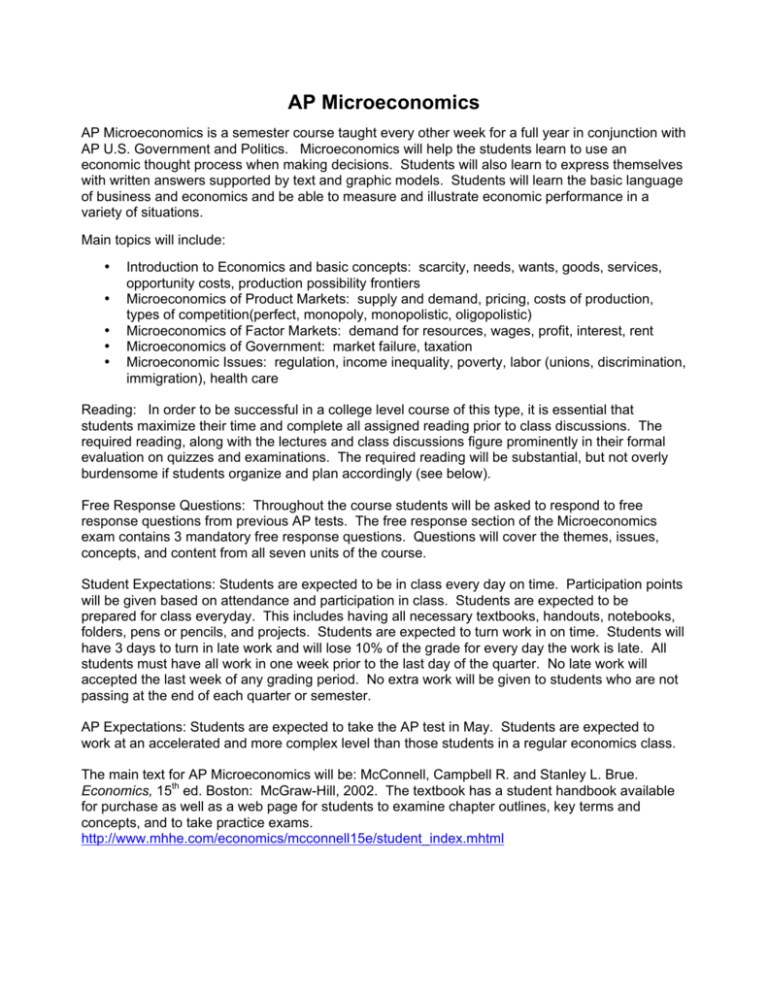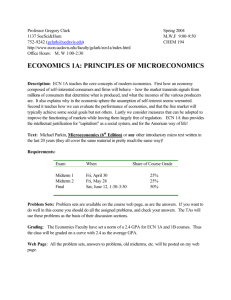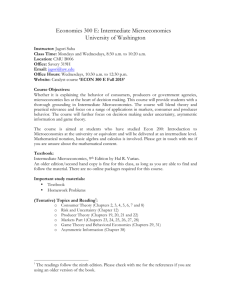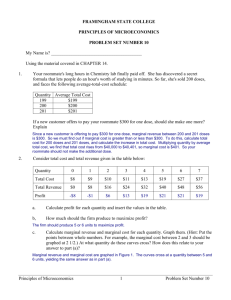AP Micro Syllabus
advertisement

AP Microeconomics AP Microeconomics is a semester course taught every other week for a full year in conjunction with AP U.S. Government and Politics. Microeconomics will help the students learn to use an economic thought process when making decisions. Students will also learn to express themselves with written answers supported by text and graphic models. Students will learn the basic language of business and economics and be able to measure and illustrate economic performance in a variety of situations. Main topics will include: • • • • • Introduction to Economics and basic concepts: scarcity, needs, wants, goods, services, opportunity costs, production possibility frontiers Microeconomics of Product Markets: supply and demand, pricing, costs of production, types of competition(perfect, monopoly, monopolistic, oligopolistic) Microeconomics of Factor Markets: demand for resources, wages, profit, interest, rent Microeconomics of Government: market failure, taxation Microeconomic Issues: regulation, income inequality, poverty, labor (unions, discrimination, immigration), health care Reading: In order to be successful in a college level course of this type, it is essential that students maximize their time and complete all assigned reading prior to class discussions. The required reading, along with the lectures and class discussions figure prominently in their formal evaluation on quizzes and examinations. The required reading will be substantial, but not overly burdensome if students organize and plan accordingly (see below). Free Response Questions: Throughout the course students will be asked to respond to free response questions from previous AP tests. The free response section of the Microeconomics exam contains 3 mandatory free response questions. Questions will cover the themes, issues, concepts, and content from all seven units of the course. Student Expectations: Students are expected to be in class every day on time. Participation points will be given based on attendance and participation in class. Students are expected to be prepared for class everyday. This includes having all necessary textbooks, handouts, notebooks, folders, pens or pencils, and projects. Students are expected to turn work in on time. Students will have 3 days to turn in late work and will lose 10% of the grade for every day the work is late. All students must have all work in one week prior to the last day of the quarter. No late work will accepted the last week of any grading period. No extra work will be given to students who are not passing at the end of each quarter or semester. AP Expectations: Students are expected to take the AP test in May. Students are expected to work at an accelerated and more complex level than those students in a regular economics class. The main text for AP Microeconomics will be: McConnell, Campbell R. and Stanley L. Brue. Economics, 15th ed. Boston: McGraw-Hill, 2002. The textbook has a student handbook available for purchase as well as a web page for students to examine chapter outlines, key terms and concepts, and to take practice exams. http://www.mhhe.com/economics/mcconnell15e/student_index.mhtml Unit 1: An Introduction to Economics Economics- Chapters 1, 2, 4 Topics: Scarcity, Choice, Opportunity Cost, PPF, Basic Marginal Benefit/ Marginal Cost Analysis, The Market System Graphs: Production Possibilities Frontiers, Slope of a Line Unit 2: Supply and Demand Economics- Chapters 3, 20, 21 Topics: Demand, Supply, Changes in Demand and Supply, Law of Diminishing Marginal Benefits, Supply, Consumer and Producer Surplus, Consumer Choice/Optimal Purchase Rule, Allocative Efficiency, Elasticity, Total Revenue Test, Price Discrimination, Price Floors and Ceilings, Efficiency versus Equity Graphs: Demand and Supply Curves (Plain, Price floors and ceilings, Elasticity), Total Revenue Unit 3: Costs and Revenues Economics- Chapter 22 Topics: Law of Diminishing Marginal Returns, Economies of Scale, Costs (fixed, variable, marginal), Cost Curves (relationship between curves), Total and Marginal Revenues, Profit and Loss (MR/MC and TR/TC), Break-Even, Shut Down, Economic Profit versus Normal Profit Graphs: Cost Curves, Revenue Curves Unit 4: Types of Competition Economics- Chapters 23, 24, 25, 26 Topics: Assumptions, Relationship between Industry and Firm, Profit Maximization, Long-Run Equilibriums, Short-Run Equilibriums and the Adjustment Mechanism, Allocative Efficiency, Relationship Between Price and MR, Barriers to Entry, Profit Maximization, Monopoly, Regulation, Natural Monopoly, Oligopoly and Duopoly Game Theory with Game Tree and Payoff Matrix (dominant strategy, Nash Equilibrium, collusion, prisoner’s dilemma, interdependence), Collusive Oligopoly, Monopolistic Competition (long run and short run) (Note: In each imperfectly competitive market structure, examine its effect on allocative efficiency and consumer and producer surplus, and make comparisons to perfect competition.) Graphs: Costs and Revenue Curves for each type of competition Unit 5: Factor Markets Economics- Chapters 27, 28, 29 Topics: Factors of Production (review definitions of marginal revenue, marginal product, the law of diminishing marginal returns), Derived Demand, Marginal Revenue Product Analysis, Optimal Purchase Rule, Perfectly Competitive Factor Markets, Profit Maximization/Cost Minimization Rules, Monopoly, Economic Rent, Distribution of Income Among Factors, Unions, Labor Market Issues Unit 6: The Role of Government Economics- Chapters 5, 30, 31 Topics: Role of Government, Public versus Private Goods, Marginal Social Cost/Marginal Social Benefit Analysis, Market Failures, Positive and Negative Externalities, Taxes, Free Riders, “Tragedy of the Commons” Unit 7: Microeconomics Issues Economics- Chapters 6, 32-36 Topics: The U.S. and the Global Economy, Anti-trust policy and regulation, Income Inequality, Poverty, Health Care










